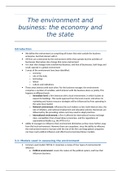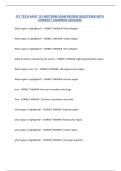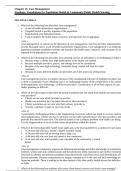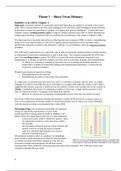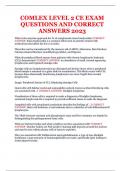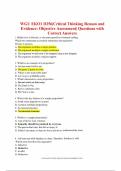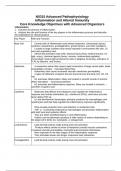The environment and
business: the economy and
the state
Introduction
We define the environment as comprising all factors that exist outside the business
enterprise, but that interact with it.
All firms are constrained by the environment within they operate but the activities of
businesses themselves also change that same environment
It is clear that changes have transformed business, and that all businesses, both large and
small, operate in a global environment
5 areas of the environment have been identified:
o economy
o role of the state
o technology
o labour
o culture and institutions
These areas interact with each other. For the business manager, the environment
comprises a number of variables, which interact with the business alone or jointly. This
happens at different levels
o Immediate level: a firm interacts with a local environment, in which it plans to
expand its buildings. This needs approval from the local council, and where its
marketing and human resource strategies will be influenced by firms operating in
the same local market
o National environment: influenced by such matters as law, bank interest rates, the
rate of inflation, and national employment and education policies. Businesses are
influenced by the prevailing culture and may need to adapt practices.
o International environment: a firm is affected by international money exchange
rates, competition from cheap labour economies, and the regulations of
supranational bodies e.g. the WTO or EU.
Ability of managers to influence their environment diminishes as they move further away
from the local environment. However there are exceptions, since the ability to influence
the environment tends to increase with the size of the firm and large global companies
can have much political influence and affect local economies/labour markets.
3.1: Models used in assessing the environment
Common used model: PESTLE. It comprises a review of four types of environmental
influence.
o Political environment: covers the nature of the political system, and how that
influences business.
, Issue: laws and regulations imposed by supranational bodies EU and
WTO.
The political environment encompasses the influence of stakeholder
groups.
o Economic environment: includes issues of economic structure, such as the
relative proportion of the economy devoted to each of agriculture, mining,
manufacturing and services. It examines issues relation to economic health,
interest rates, and unemployment levels.
o Socio-cultural environment: Influences resulting from the changing composition
of the population such as an increase in the proportion of older people. It
considers skill composition of the labour force, and the relationship between
skills/educational system
o Technological environment: issue is the influence of new or changing technology
on strategies, practices and jobs. Major change: impact of
information/communication technology.
o Legal environment: legal regulations affect businesses through stock market
regulation of mergers and takeovers, corporate law covering such issues as
taxation, contract law dealing with the relationship with customers/suppliers and
lastly employment law dealing with how employees are treated.
o Ethical environment: examines the implications of ethical/environmental issues,
e.g. rates of pay, employment of child labour, use of energy, etc.
3.1.1: Critique of pest
Influences operate together, and cannot be understood on their own
PESTEL approach offers a lot of overlap: categories are part of each other
It focuses upon factors operating on the firm. Little/no acknowledgement that
organisations can influence the environment
The model is static: focuses on present factors only.
Other models which examine external opportunities and threats.
3.2: Ownership
Assumption: ownership is an important variable in determining the goals and the way
that business operates.
Discovering who owns/controls businesses becomes complex with large corporations.
3.2.1: Types of Ownership
Sole trader
The most common form of business ownership. A sole trader can employ staff. They are
found in most small business start-ups
Examples: hairdressers, electricians, consultants.
Advantage: unlimited personal liability. Any debts are the responsibility of the owner.
Partnership
Found in professions e.g. law, accounting and medicine.
A partnership also has unlimited personal liability and partners may have their personal
assets placed at risk to cover losses
business: the economy and
the state
Introduction
We define the environment as comprising all factors that exist outside the business
enterprise, but that interact with it.
All firms are constrained by the environment within they operate but the activities of
businesses themselves also change that same environment
It is clear that changes have transformed business, and that all businesses, both large and
small, operate in a global environment
5 areas of the environment have been identified:
o economy
o role of the state
o technology
o labour
o culture and institutions
These areas interact with each other. For the business manager, the environment
comprises a number of variables, which interact with the business alone or jointly. This
happens at different levels
o Immediate level: a firm interacts with a local environment, in which it plans to
expand its buildings. This needs approval from the local council, and where its
marketing and human resource strategies will be influenced by firms operating in
the same local market
o National environment: influenced by such matters as law, bank interest rates, the
rate of inflation, and national employment and education policies. Businesses are
influenced by the prevailing culture and may need to adapt practices.
o International environment: a firm is affected by international money exchange
rates, competition from cheap labour economies, and the regulations of
supranational bodies e.g. the WTO or EU.
Ability of managers to influence their environment diminishes as they move further away
from the local environment. However there are exceptions, since the ability to influence
the environment tends to increase with the size of the firm and large global companies
can have much political influence and affect local economies/labour markets.
3.1: Models used in assessing the environment
Common used model: PESTLE. It comprises a review of four types of environmental
influence.
o Political environment: covers the nature of the political system, and how that
influences business.
, Issue: laws and regulations imposed by supranational bodies EU and
WTO.
The political environment encompasses the influence of stakeholder
groups.
o Economic environment: includes issues of economic structure, such as the
relative proportion of the economy devoted to each of agriculture, mining,
manufacturing and services. It examines issues relation to economic health,
interest rates, and unemployment levels.
o Socio-cultural environment: Influences resulting from the changing composition
of the population such as an increase in the proportion of older people. It
considers skill composition of the labour force, and the relationship between
skills/educational system
o Technological environment: issue is the influence of new or changing technology
on strategies, practices and jobs. Major change: impact of
information/communication technology.
o Legal environment: legal regulations affect businesses through stock market
regulation of mergers and takeovers, corporate law covering such issues as
taxation, contract law dealing with the relationship with customers/suppliers and
lastly employment law dealing with how employees are treated.
o Ethical environment: examines the implications of ethical/environmental issues,
e.g. rates of pay, employment of child labour, use of energy, etc.
3.1.1: Critique of pest
Influences operate together, and cannot be understood on their own
PESTEL approach offers a lot of overlap: categories are part of each other
It focuses upon factors operating on the firm. Little/no acknowledgement that
organisations can influence the environment
The model is static: focuses on present factors only.
Other models which examine external opportunities and threats.
3.2: Ownership
Assumption: ownership is an important variable in determining the goals and the way
that business operates.
Discovering who owns/controls businesses becomes complex with large corporations.
3.2.1: Types of Ownership
Sole trader
The most common form of business ownership. A sole trader can employ staff. They are
found in most small business start-ups
Examples: hairdressers, electricians, consultants.
Advantage: unlimited personal liability. Any debts are the responsibility of the owner.
Partnership
Found in professions e.g. law, accounting and medicine.
A partnership also has unlimited personal liability and partners may have their personal
assets placed at risk to cover losses

